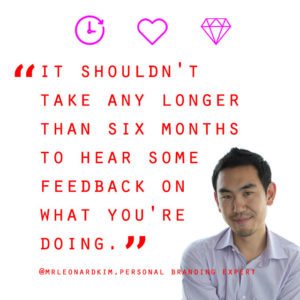Here’s the scenario: you have a steady gig and a steady passion project going, too. Or, you may be one of the lucky ones for whom those things are one and the same. Nevertheless: You’re on your grind (and probably on a lot of Red Bull, too). As you’re moving and grooving through your to-do list, how do you know when it’s time to up the game and do more?
That’s what I asked Red Rachel Richards, a NYC-based storyteller and actress:
Rachel says, for her, it’s having people around that will hold her accountable and listening to that nudge (or whisper) that tells her it’s time.
I also reached out to Leonard Kim, a personal branding expert and speaker (“guru” is appropriate here!) to get his thoughts.
Leonard says to watch what’s working best.
How do you know when it’s time to do more?
It’s time to do more when you are starting to see the results of what you are putting into your project. Once a seed starts to blossom into a sprout, it needs to be fed and nourished so it could grow. It’s so much easier to get a sprout to blossom into something bigger when you invest your resources into it. So once you start to get that traction, continue onwards and dedicate more resources to your project.
How do you know when it’s too much?
You’re already working full time on your living and part time on your fortune. That’s a great place to be. And I know just how much of a struggle it can be, as I’ve done that for myself as well. The goal here is to stretch yourself to do more, but without causing burnout, especially if you are in a relationship or have children and other responsibilities you need to cater to.
Let’s talk more about that! I found out from Rachel what burnout means to her, and how she avoids it:
Back to Leonard, who also let us in on his secret of how long you should keep your project going before determining if it’s working well for you.
How do you know when it’s time to do something differently or change course?

How long have you been at your project? Three months? Six months? A year? What kind of results have you seen? If you haven’t seen any, you may be on the wrong track. I mean sure, it does take time to get the initial traction to what you are doing, but it shouldn’t take any longer than six months to hear some feedback on what you’re doing and generate some interest. Before you start your next project though, you need to make sure the market wants what you have to offer. Try setting up a small budget of less than $1,000 and run a few Facebook ads based on a few different topics. If no one is engaging with your topic, then you either need to test different copy with the same message, or move to the next topic. Find the topic that works and generates the most engagement and start with that for your next project.
You may be doing lots of things. How do you know you’re doing the right things, in the right order?
What part of what you are doing are the most people interacting with? When you discover that, you need to draw a line from there to where you want them to go. If people are mostly interacting with, say, your blog, you need to invest into making that as compelling as possible. Then you need to think of what your blog leads to. Is it an email list? That means you need to work on your email capture form next. Then the email funnel. Then from the email funnel, the products and services you want to offer. You need to use feedback from the existing data you have already to determine where to invest your time.
Big thanks to Red Rachel and Leonard Kim for their insights! You’ll hear more from them in the coming weeks here. And we want to hear from YOU: how do you know when it’s time to do more? How do you avoid burnout? Tell Kyle: @KyleCollins on Twitter or @KyleInterviews on Instagram.
Kyle & Rachel’s photos and videos by Brandon Deyette. Leonard’s photo by Joshua M. Shelton.
